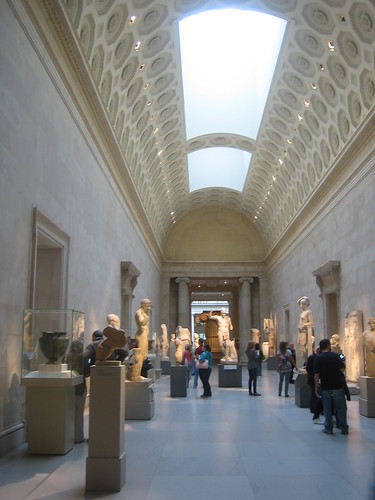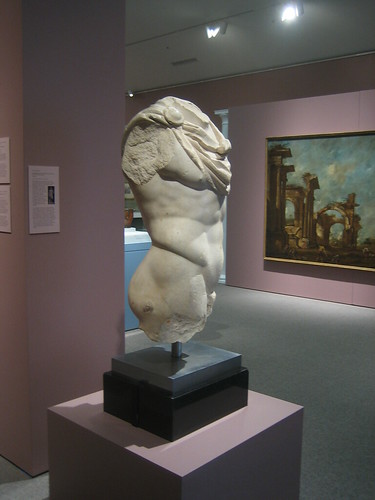 |
| A tiny clay sculpture of John the Baptist at the Bode Museum in Berlin is attributed to the 15th-century Luccan artist Matteo Civitali. |
He continued that "a few minutes' walk from the Bode, the Friedrichswerdersche Kirche, the rebuilt neo-Gothic former church designed by Karl Friedrich Schinkel in the 1830s, houses its own sublime assortment of 19th-century sculpture. It's usually even emptier than the Bode, and it is free to boot. I'll occasionally spend an hour or so there, feeling small and unimportant before the portraits of Kant and the great German archaeologist Johann Winckelmann. Except for the doleful guards, I rarely encounter another living soul."
 |
| Roman and Greek Wing, Metropolitan Museum of Arts, New York |
I am a painter, not a sculptor, therefore I am afraid that my visits to museums often concentrated on the painting wings. I had been asked to make sculptures many times but just couldn't abandon my tubes of paints, even temporarily. Same thing happened to printmaking, etc. I did make one sculpture of clay, a golden fish, in elementary school. It was not very interesting, I think.
I understand sculpture less well than paintings, therefore, sculptures need to have higher quality and meaning to attract my attention. I can enjoy completely innocent and whimsical paintings but for sculptures, if they failed to touch me with visceral impacts, I lose my interesting quickly. This is not to say that I'm crazy about colors. My palettes are often muted and even monochromatic. I do see not being bound to verisimilitude in paintings as a plus in art creation.
 |
| Marble Tors, Cantor Arts Center, Stanford University |
I just saw the last installment of Harry Potter movies, IMAX, 3D version. It was not a good movie. The 3D effects neither added nor subtracted. The whole experience was actually more aural-based. The theater blasted its high-tech sound system during commercials, previews and the feature. I watched the entire movie with my ears plugged and hear the movie as clearly as any other normal movie experience.
It seems that nowadays anything less flashy would be appreciated less accordingly. In order to make a big impact with art, even paintings - however colorful - are in no position to gloat.
It must be a gargantuan installation, and better still to have performing elements built in.
Soon, painters would bemoan our abandoned fates as those old sculptors. I felt like a medieval monk already.
 |
| Nezha by Zhang Huan, San Francisco |





No comments:
Post a Comment